Continental Kryptotal Tires
Diameters Offered: 27.5’’ and 2.9’’
Stated Width:
- Kryptotal Front: 2.4’’
- Kryptotal Rear: 2.4’’ (tested) and 2.6’’ options
Blister’s Measured Width (on 30 mm internal width rim):
- Kryptotal Front 2.4’’: 2.47’’
- Kryptotal Rear 2.4’’: 2.39’’
Blister’s Measured Weight:
- Kryptotal Front 2.4’’, DH casing, SuperSoft rubber: 1,268 g
- Kryptotal Rear 2.4’’, DH casing, Soft rubber: 1,304 g
- Kryptotal Rear 2.4’’, DH casing, SuperSoft rubber: 1,303 g
MSRP: $65–100 (varies by construction)
Reviewer: 6’, 175 lbs / 183 cm, 79.4 kg
Test Locations: Washington, British Columbia
Test Duration: 5 months
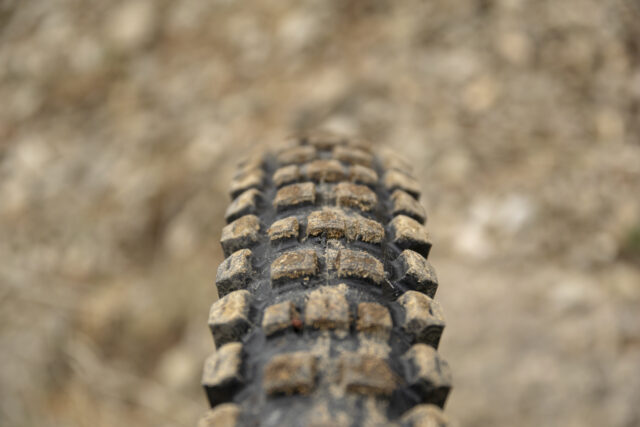
Intro
Continental has been making mountain bike tires for a long time, but historically have lagged behind some of their competitors in terms of popularity. So Continental went back to the drawing board and completely overhauled their gravity tire range, with new tread patterns, rubber compounds, and casing constructions — new everything. And having now spent a lot of time on their Kryptotal tires, the results are very, very good.
The Kryptotal pair (there are separate front and rear versions) are meant to be the versatile all-rounders for aggressive use in variable dirt. Continental also offers three other tread patterns in their new gravity line, the Xynotal (a faster-rolling option for hardpack use, especially as a rear tire), the Argotal (a mid-spike for softer conditions) and the Hydrotal (a true mud spike).
The whole range shares the same new rubber compounds and casing options, though not every tire model is available in every possible combination. We’ll kick things off with the Kryptotals here, and have also been spending time on the Argotal — so stay tuned for more on that one soon.
Design
The whole range of Continental gravity tires is offered in three new rubber compounds and three new casing options, and their naming convention is refreshingly straightforward: “Endurance,” “Soft,” and “SuperSoft” for the rubber compounds, and “Trail,” “Enduro,” and “Downhill” casings.
Casings
First up is the Trail casing, Continental’s lightest option for the new gravity range. It uses 110 TPI fabric with two layers of fabric in the sidewalls and a third under the tread for increased puncture resistance. A folding Aramid bead is used, and Continental aimed to keep the Trail casing relatively lightweight and supple. We haven’t tried the Kryptotal in the Trail casing, but have a pair of the Argotals in that construction (again, more on those coming soon); their measured weight comes in very close to Continental’s claimed weight of 1,040 g for the 29’’ x 2.4’’ size, and they feel in a similar ballpark to Maxxis’ Exo casing in terms of weight and puncture protection.
The Enduro casing is the next step up in toughness, and it’s essentially the same as the Trail casing, but with the addition of a butyl insert at the bead for improved pinch flat protection. We haven’t tried the Enduro casing yet, but Continental claims that it adds about 85 g per tire over the Trail one. On paper, that makes it sound broadly comparable to Maxxis’ Exo+ construction, but we’ll need to get on a set of those soon to confirm.
Finally, the Downhill casing, tested here, doubles up the casing fabric to four layers in the sidewalls and six under the tread for extra durability and support. The bead is still a folding Aramid one but is thicker and burlier than that used in the Trail and Enduro tires, and a butyl insert similar to that used in the Enduro casing is featured as well.


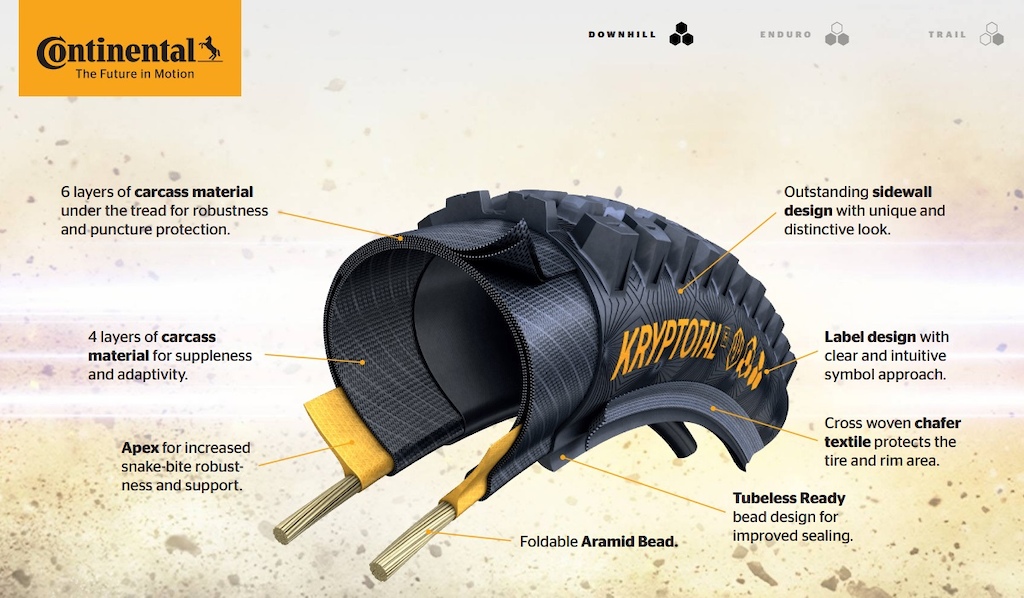
We’ve weighed a handful of the 29’’ x 2.4’’ DH Kryptotals in all three rubber variants (Front SuperSoft, Rear SuperSoft, and Rear Soft), and the Rears reliably weigh right around 1,300 g each (regardless of rubber compound) and the Fronts are actually slightly lighter, at around 1,270 g, despite measuring slightly wider. Those are relatively close to Continental’s claimed weights, though our Kryptotal Rears are coming in a little heavier than stated. Those weights are slightly on the lighter side for Downhill casing tires, but not by a big margin — for example, Maxxis’ newer folding-bead DH tires in similar models tend to be roughly 50 to 80 g heavier.
While I quite like the ride quality of the DH casing (more on that below), I have found them to be notably difficult to mount on certain rims. The bead seems to be just a touch tighter than average, and is also relatively thick. On rims with a sufficiently wide inner channel to accommodate the full bulk of the bead, they’ve felt notably tight but generally doable; the one rim that I wasn’t able to get the Kryptotal DHs on was the Enve AM30. In that case, the combination of the tight bead and narrow rim channel meant that I couldn’t get the second bead onto the rim with a valve stem installed. Mounting the tire without a stem was fairly straightforward (but also not helpful); with a stem in place, the bead gets displaced out of the inner channel and becomes too tight to get the second side on.
Chalk that one up to a combination of a tight-fitting rim and especially snug tires. I’ve gotten the Kryptotal DHs on Reserve 30|HDs, We Are One Unions, DT Swiss EX511s, and Reynolds Blacklabel Trail 329s without too much trouble, though they are still notably snug on all of those wheels.
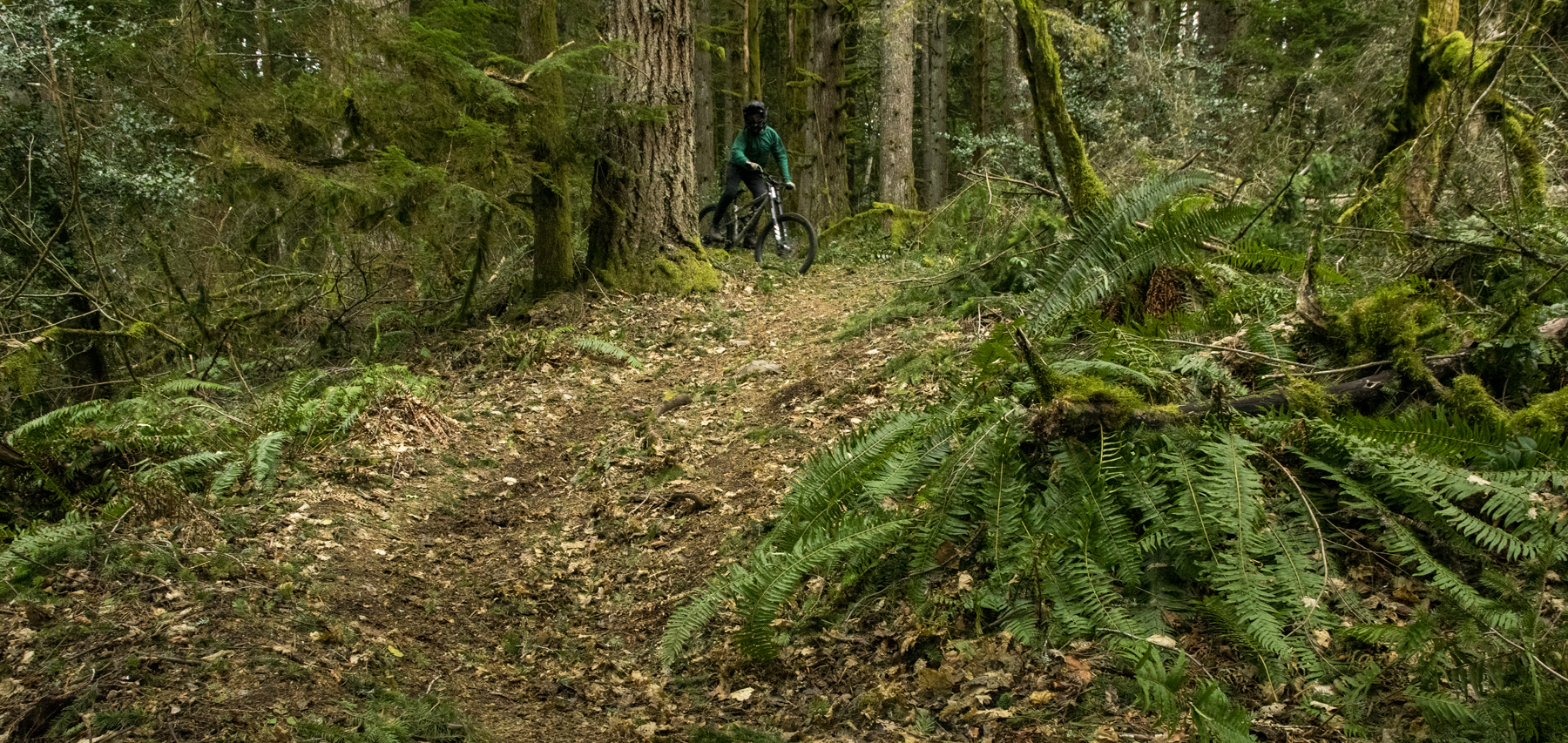
Rubber Compounds
As with the casings, Continental offers three different rubber compounds, dubbed “Endurance,” “Soft,” and “SuperSoft.” Predictably, the softer rubber compounds are meant to offer more grip at the expense of rolling resistance and durability. Continental doesn’t state durometer measurements for any of the rubber compounds or offer much information on how they’re formulated, arguing that durometer isn’t the be-all, end-all determinant of how a rubber compound is going to perform and that advertising that information is liable to confuse more than it helps.
For the entire gravity range, the Trail casing tires are currently offered in Endurance rubber only; the Enduro ones with Soft rubber exclusively; and in order to get the SuperSoft rubber, you need to step up to the Downhill casing. Some tire variants are also available in a Downhill / Soft configuration. In the case of the Kryptotals, both the Trail and Enduro casings are available in 2.4’’ widths for the Kryptotal Front and the Kryptotal Rear comes in both 2.4’’ and 2.6’’ widths; the DH casing only comes in 2.4’’ widths for both versions, with the Kryptotal Rear offered in Soft and SuperSoft rubber and the front available with the SuperSoft version only. All the versions described here are offered in 27.5’’ and 29’’ diameters.
The options vary for the other models in the line. It’s a lot to keep track of, but Continental has a chart that lays it out fairly concisely (considering that we’re talking about 40 total tire variants across the whole range).
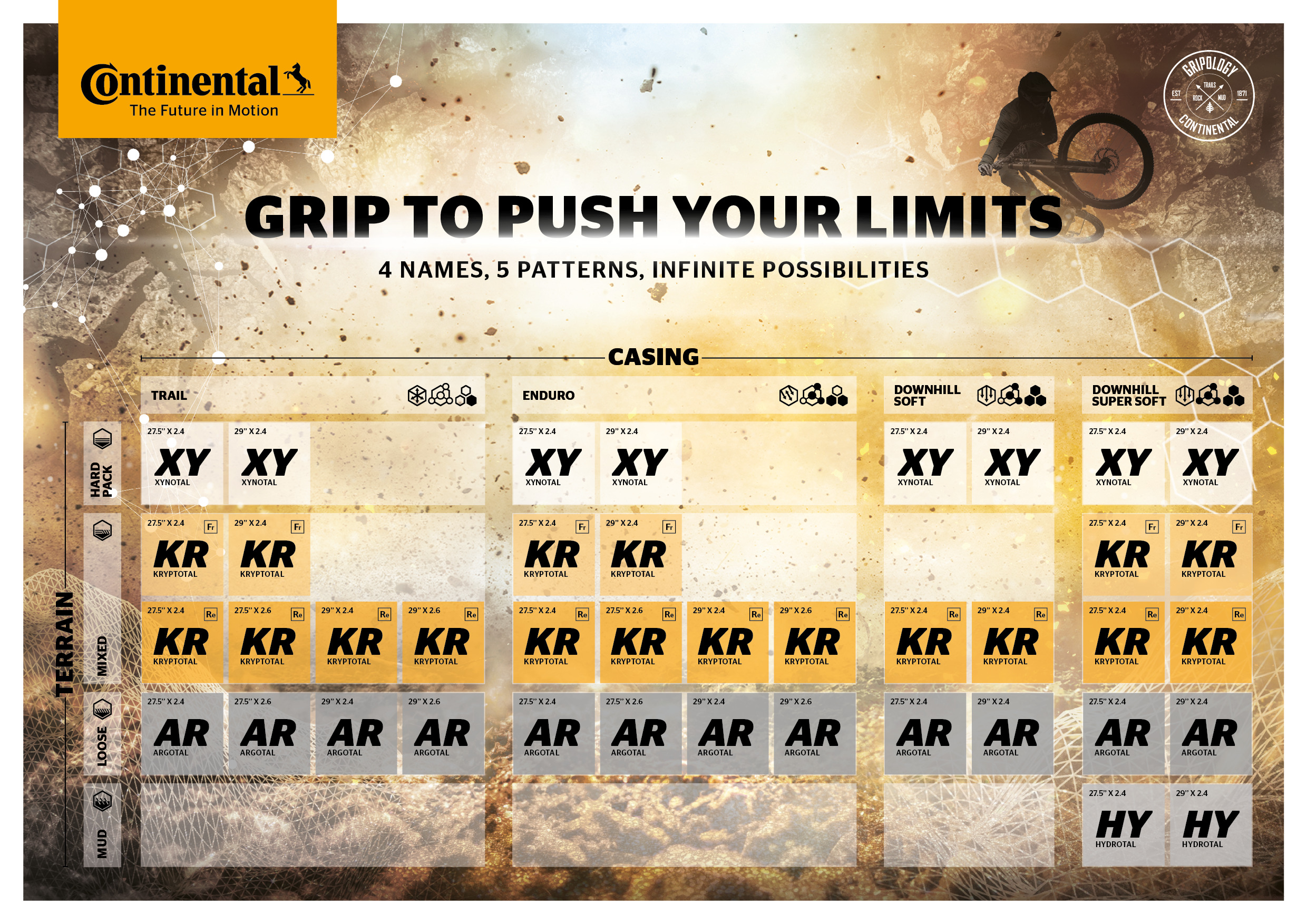
It’s somewhat interesting that Continental offers the Argotal Rear in a wider 2.6’’ width (in the Trail and Enduro constructions) but not the front. The larger rear tire is predominantly intended for e-bikes, to help them maintain traction under power, but there’s no reason you can’t run one on a conventional bike if you’re so inclined.
It’s also notable that the SuperSoft rubber is only available on the Downhill casing, at least for now. Continental has hinted that they might expand their offerings to include some options for a SuperSoft Enduro construction at some point, which would make a lot of sense — especially because, as we’ll get into more below, the SuperSoft rubber is not that wildly soft. We’ll just have to wait and see, though.
Tread Patterns
The Kryptotal pair has different tread patterns for front and rear use — in contrast to Continental’s other new gravity tires. And while the Kryptotal pair looks quite a bit like some other tire designs at first glance, there are some interesting details here that set them apart.
Kryptotal Front
At first glance, the Kryptotal Front looks quite a bit like a Maxxis Assegai, with alternating rows of knobs in a paired (row A) and three-wide (row B) arrangement. The two wide A1 knobs feature laterall sipes, with the alternate A2 ones featuring longitudinal ones, and the Kryptotal’s sipes only run through the middle of the knob instead of along its full length / width, and the Kryptotal’s center B knob isn’t siped, in contrast to the Assegai’s.
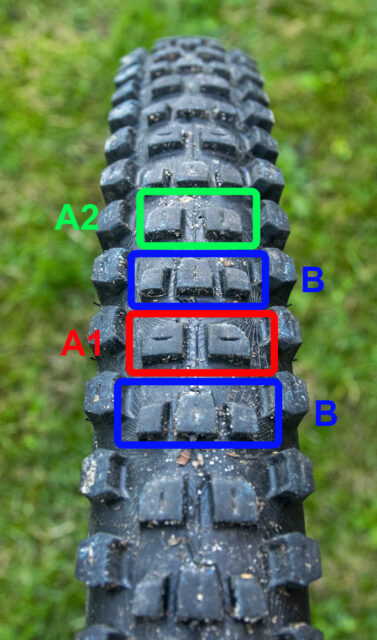
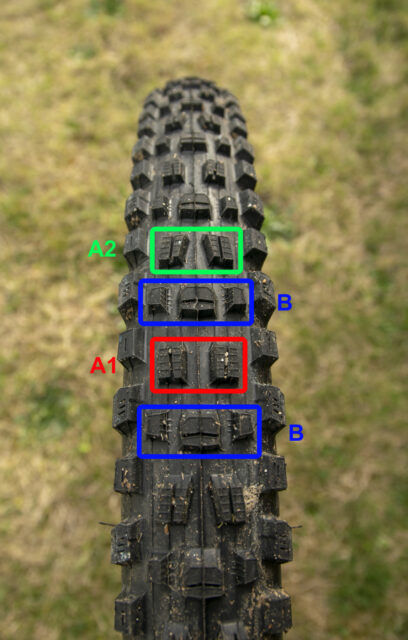
While the overall knob design is quite similar, there are real differences in how the two are laid out. The Assegai’s center knobs are more widely spaced, the A knobs are actually oriented in two slightly different configurations (A1 and A2, above), and the outer transition knobs of the B row extend farther into the channel between the side and center knobs; in contrast, the two rows of center knobs on the Kryptotal Front have a similar overall width, with a more pronounced channel between them and the side knobs. That channel isn’t as wide as on some tires, such as the Maxxis Minion DHF, and the Kryptotal’s overall profile is comparatively squared off. Indeed, the Kryptotal Front feels like something of a middle ground between the Assegai and the DHF in terms of how much commitment it takes to engage the side knobs. More on that below.
And speaking of the side knobs, their design varies much more substantially from that of the Assegai. The Kryptotal uses a single side knob design, and it’s a blocky, angular affair with a small longitudinal sipe down the middle and a substantial cup shape on the inner edge to help with cornering bite. The knobs are also angled slightly, with the leading edge toed inward (notably in the opposite direction than Schwalbe tends to angle side knobs on a lot of their tires, including the Magic Mary). The Continental angle makes more sense, in my estimation — with that angle, braking while cornering is going to tend to pull the tire in toward the inside of the corner, whereas the Schwalbe angle has the tendency to push the tire outward.
Kryptotal Rear
The Kryptotal Rear bears a substantial resemblance to the Maxxis Minion DHR II, particularly in terms of the center tread. The Kryptotal Rear uses two alternating rows of center knobs, which we’ll call A and B; the A knobs are wider, with a sharp trailing edge for braking bite and a bit of a ramp on the leading edge to help reduce rolling resistance. The overall layout is quite similar to that of the DHR II, with the biggest difference being that the DHR II has two different variants of the “B” knobs (let’s call those “B1” and “B2”) that alternate between each of the A rows; the Kryptotal Rear’s B knobs are quite similar to the B1s on the DHR II, while the B2 is more of a full-width block with a couple of longitudinal sipes. The lateral sipes in the Kryptotal Rear’s A knobs also only cut through the middle portion of the knobs, while on the DHR II they extend the full width, but the designs share a lot in common.

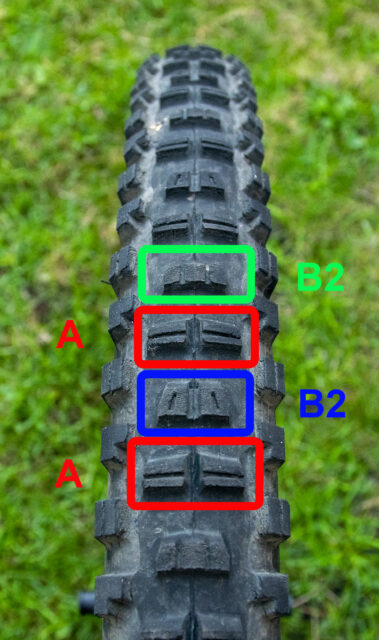
On the Trail
One of the most immediately striking things about the Kryptotal pair — even in the DH / SuperSoft configuration — is how well they roll for this sort of tire. Of course, that’s a very relative statement. We’re still talking about aggressive tread patterns here, and if rolling resistance is truly a top priority, there are much faster-rolling, more XC-oriented options out there.
But compared to, say, a Maxxis Assegai / Minion DHR II combo in a DH casing / 3C MaxxGrip rubber configuration, the DH Casing / SuperSoft rubber Kryptotals roll substantially quicker. And in a lot of ways, the Kryptotal Rear reminds me quite a bit of a DHR II that rolls somewhat faster, but gives up a little bit of braking bite in order to get there, especially on firmer, harder surfaces. Interestingly, the gap in braking bite seems to decrease somewhat as things get looser and softer, though the DHR II still wins by a bit even in softer dirt.
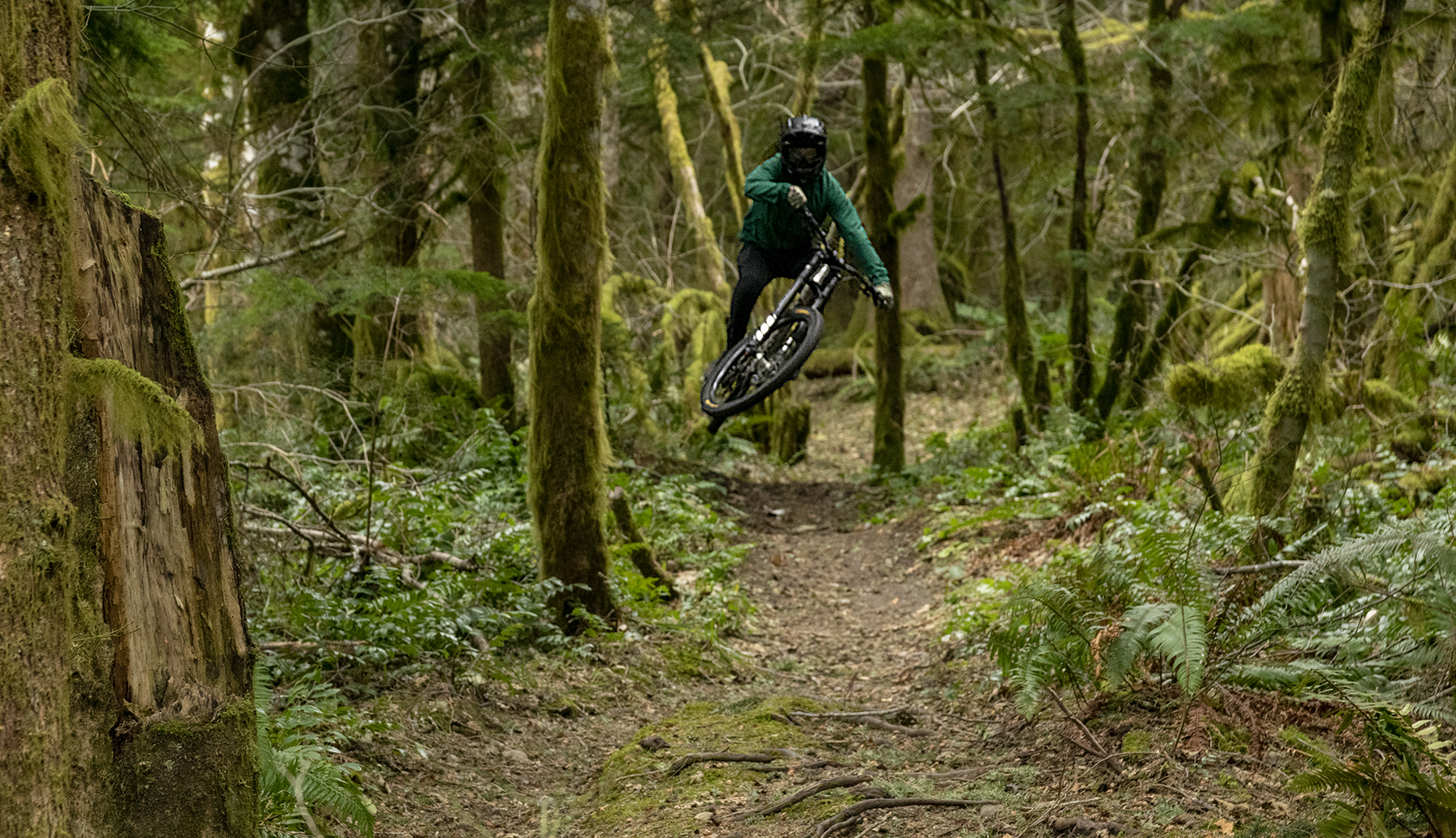
The Kryptotal Front, though, is maybe the more interesting of the two. In most conditions short of very loose and wet, it’s one of the very best braking tires I’ve ever tried. The overall level of grip is very, very good, but just as importantly, the Kryptotal Front does an especially good job of tracking straight and predictably when it does lose traction under heavy braking. I found this most notable in late summer when the trails around here had gotten quite dry and loose, with a harder base below the dust on top. Those sorts of conditions + steep chutes are a great recipe for sketchiness, but the Kryptotal Front’s braking performance in those scenarios is seriously impressive. It’s a clear step above the Maxxis Assegai or Minion DHR II, and miles better than the Minion DHF in that regard. It’s been a while since I’ve been able to get on a Schwalbe Magic Mary in really dry, loose conditions, but I think the Kryptotal Front has more outright braking traction than the Magic Mary, too, and it’s clearly more predictable than the Magic Mary at the limit of braking traction when it starts to break loose and start to slide. That’s especially important for a front tire, but nothing about the Kryptotal Front’s performance makes me think it would work poorly as a rear tire, either, particularly if you want more braking traction than the Rear version has on offer.
The Kryptotal Front’s cornering grip is also quite good in most conditions, especially drier to moderately wet ones. The tighter-spaced tread pattern can start to clog up in sticker, wetter dirt a little more readily than tires with a more open pattern (like the Assegai), but in trade for that, both of the Kryptotal versions feel more supportive and less squirmy when cornering hard on firmer dirt or rock, even in the SuperSoft rubber compound. Of course, Continental offers two softer-condition-oriented tires in their new gravity lineup (the mixed-condition Argotal and the mud spike Hydrotal) so maybe it’s not such a great surprise that they’ve inched the Kryptotals slightly toward drier, firmer conditions.
That said, the Kryptotal pair is by no means a dry-only tire combination or anything like that. They’re just biased a little further in that direction than things like the Maxxis Assegai or Schwalbe Magic Mary. While the Kryptotals’ tread patterns are a little more tightly packed and prone to clogging with mud than some of those other designs, at least for my preferences and the typical conditions in the Pacific Northwest, their biggest limitation for me, as conditions start to get damp (but short of full-on sloppy), is their lateral grip on wet roots. That’s not to say that the Kryptotals are super sketchy on them or anything like that, but they’ve got notably less grip on them than a 3C MaxxGrip Assegai or (especially) a MaxxGrip DHF; the SuperSoft Kryptotals are a little better than a MaxxTerra Assegai and close to the DHF in that same rubber, while being significantly more predictable than the e*thirten Grappler MoPo, for example.

Continental is certainly right to note that rubber durometer (i.e., hardness) isn’t a perfect predictor of how a given compound will perform, but I still think there’s room for them to go softer and stickier with their rubber compounds. The SuperSoft Kryptotal Front works really well in a lot of conditions, and both rolls and wears notably well relative to its overall performance, but its lateral grip on wet roots, in particular, could be better — and that’s an area where very soft rubber tends to help a lot. And it feels like a real limitation that you need to step up to the Downhill casing to get that not-all-that-crazy-soft rubber, at least for the time being. I love the way the Downhill casing rides and am happy using it on bigger Enduro bikes for the ride quality and sidewall support, but I’m sure that there are folks out there who’d prefer a SuperSoft Enduro (or even Trail) option.
To put an even finer point on it, I’m really not interested in running anything harder than the SuperSoft rubber as a front tire, at least for the sorts of bikes where the Kryptotal tread pattern would be appropriate, and I overall prefer the SuperSoft Kryptotal Rear to the Soft version, even on Enduro bikes that I’m pedaling to the top of most descents. In the SuperSoft rubber, the Kryptotal pair rolls well enough and is hard enough wearing for me to not have much interest in anything firmer — and again, if there’s anything about their performance that I don’t like, it’s that wet-root lateral grip could be better. If Continental rolled out a SuperDuperSoft rubber compound tomorrow, I’d be thrilled.
Granted, I live in a part of the world where wet roots are a far more regular fact of life than they are in a lot of places, and I’m not arguing for this hypothetical SuperDuperSoft rubber to be the only option or anything like that — but I’d love to see it as an option. Given my experience on the very hard Endurance rubber on the Argotals (a tire that makes especially little sense in a hard-rubber variant), I’m not really sure who that rubber compound is really going to work well for. None of the new gravity tires are especially fast-rolling designs when compared to the whole market (though again, the Kryptotals do roll very well for how aggressive they are). Folks who really care about weight and rolling resistance are going to be better off with completely different designs, no matter the rubber compound; if you want a tread pattern this knobby, you probably also want softer rubber to go with it.
But again, I really, really like the SuperSoft Downhill versions of the Kryptotals — especially in the drier summer months around here, when wet roots aren’t in the picture as much, but true hardpack is still rare — and I’m making a big fuss about the details because the Kryptotals are already so good, and just feel like they’ve got the potential to be even better.

The Kryptotal Front has a ton of cornering grip in a fairly broad range of conditions, brakes extremely well, and rolls impressively well for how good it is in those other respects. The Rear version gives up some braking bite as compared to the Front in exchange for rolling even better, and while the Kryptotal Front is notably squared off in terms of its profile, its side knobs are supportive enough to make that work nicely. The two tires are also nicely matched to each other, with the Rear being just a touch more round and being correspondingly a touch quicker to break free into a drift — nicely sorted out all around.
The Downhill casing rides extremely well, balancing suppleness and sidewall support very well, and has proven to be quite durable and puncture-resistant. It’s especially supple and rides more smoothly than a lot of other DH casing options from other brands (notably Michelin and, to a lesser extent, Maxxis) while still being quite supportive and better damped than most thinner, lighter options. It’s very, very good, and though I’m sure that some folks would prefer that a lighter casing option be available with the SuperSoft rubber, I’m personally quite happy with the DH one, as someone who tends to prefer Maxxis’ DoubleDown casings, at a minimum.
Bottom Line
Continental has taken a very, very big step forward with their new gravity tire line, and the Kryptotal pair is a great option for riders looking for a relatively aggressive all-rounder tread pattern that rolls notably well, brakes great, and is generally predictable and consistent in a broad variety of conditions. It’s too bad that the softer rubber compounds aren’t available (at least yet) in some of the lighter constructions, and there’s probably room for an even softer rubber option than the not-that-wildly-soft “SuperSoft” that sits atop the range, but especially if your conditions generally trend toward the drier to medium side of the spectrum, the Kryptotals are very impressive.

If antone can compare the Kryptos (and the Argos) to the last gen Kaiser/Baron, that would be very interesting
anyone……
They don’t look that similar, so I don’t think it’d be an apples-to-apples comparison. Also – and I might be wrong on this, so please correct me if I am – the treads on the Kaisers and Barons look like they’re ramped on the braking edge. If that’s the case, they’re probably be a lot worse than the Argos and Kryptos (and many other tires).
Yeah, should have been more precise.
The use-case for the Kaiser / Baron was, as I see it, similar to a Krypto Re / Argo- combo, so even though the thread is not that similar a comparison would be interesting for those (few) of us that has been on Conti previously.
Especially with regards to how the old Black Chilli compound compares to the new ones. I felt that my Kaiser / Baron combo was better in every way than for example a dhrII maxxt / dhrII maxxg combo
David, I’m surprised that you didn’t touch on what I perceived to be the elephant in the room. You extoll the fast rolling traits of these tires and simultaneously bemoan the lack of an ultra soft rubber compound. My impression is that these two traits are in opposition to each other, akin to weight and stability in skis. Like skis, there are other factors at play (namely tread pattern), but I was hoping you would weigh in some more on the balancing act between durometer and rolling resistance and how you thought these tires compared to say a softer but slower maxxgrip setup in that department. I think that too many riders just assume softer is better and leave it at that, while these tires have started to challenge that notion for me.
Yes, I got myself a pair a few weeks ago, (same specs as you, I think) and like you immediately noticed the lack of rolling resistance for such a burly tire. I did also notice that the rear tire especially had more of a tendency to slip on the wet roots here in the PNW than my previous maxxterra rubber. Nonetheless, I’ve been able to counteract that pretty easily by shifting adjusting cadence and positioning slightly. On the flip side, I notice the faster rolling literally everywhere else on trail. For me, I think the trade-off is a no brainer and something I wasn’t necessarily expecting to observe. I agree with your other remarks on excellent braking, predictability, and casing feel.
Definitely don’t mean to sound critical, I really enjoy your content and just wanted to voice my 2cents. Cheers and enjoy these prime winter conditions!
Hey Nic,
You’re definitely right that super soft rubber and rolling resistance tend to be in conflict with each other, but that’s actually a big part of why I think having the *option* for an even softer compound would be great — Continental has hit upon tread patterns that roll impressively well for how aggressive they are, and their SuperSoft rubber is not that wildly soft, which is absolutely going to be a good thing for some people. Not everyone should be immediately defaulting to the softest option on every tire (and for example, I personally tend to run a MaxxGrip DD DHF or Shorty front / MaxxTerra DD DHR II rear combination on enduro bikes for just that reason).
But Conti’s SuperSoft rubber just isn’t as soft as MaxxGrip or Schwalbe Ultra Soft, and I’d like a tackier option for at least front tire use. And to be clear, when I’m talking about wet root grip, my primary gripe is from the front tire when descending at speed. A bit of rear tire slip is a lot easier to correct for, but I really want the front to stick.
David,
Definitely agree that options are good, and totally understood that sentiment from the article. Which riders on which trails would benefit from that theoretical supersoft option is more what I was bringing into question. Thanks for clarifying about the wet root traction. I personally tend not to put much trust in my front tire on nasty wet roots at speed regardless of tire choice, so perhaps we differ in that regard.
On the topic of predictability, I wonder again how much durometer plays a part here. I thought these tires felt precise and predictable, could that be in any way related to durometer? Perhaps a future Blister Labs project.
Thanks again for the great stuff and thoughtful response!
Do you think there is any rolling speed difference between the Fr and Re?
You mentioned the Re rolls faster than an equivalent DHR2, would you put it in the DHF rolling speed category?
And what do you think of cornering traction against the Assegai, DHR2 and DHF? Braking traction is mentioned, but I’m curious for cornering grip!
Thanks
Cam,
The Krypto Front tested at 21 W and the rear at 19 W in the Endurance (fastest) compound. So, nearly identical. I have not seen recent tests of the DHF , but the generally tread difference doesn’t make as big a difference as compound, so looking at other Maxxis tires in Maxterra, comparing too Conti Soft:
Exo casing:
Shorty: 29W
Dissector: 25W
Assegai: 28 W
DHR II: 29 W
Looking at these numbers, and knowing that there is a fair bit of variation in individual tire samples, I would bet the DHF rolls similar, perhaps a hair better than the DHR, but generally very close.
DHR II :Double down casing MaxxTerra:32 W
Krypto Rear enduro casing, soft: 34 W.
The Conti Enduro casing is comparable to double down in weight and pinch flat protection.
In my post below, you can see that once you get into supersoft and MaxxTerra compound, the Conti is faster rolling than Maxxis.
A little late for this but I just wanted to say that the Kryptotal Frs look like Maxxis Dissectors on steroids.
Curious… what psi were you running during testing?
Wondering how they compare to Michelin gravity options ?
I’d love to hear you compare these to the specialized butcher T9 and eliminator T7 in trail and dh casing. Looking for a bike park set up and these are looking promising!
David wrote: “ Of course, that’s a very relative statement. We’re still talking about aggressive tread patterns here, and if rolling resistance is truly a top priority, there are much faster-rolling, more XC-oriented options out there.”
Interestingly, the Trail casing, Endurance compound tires, fall squarely in the ‘light trail’ category, despite agressive tread and fairly solid casing.
The grip is not so high, according to number outs reviews, but the rolling resistance is very low:
Comparable to Nobby Nic Speedgrip, or Vee Crown tires.
I think that makes them sound very interesting for rear tire use in dry, rocky areas.
David wrote: “ But compared to, say, a Maxxis Assegai / Minion DHR II combo in a DH casing / 3C MaxxGrip rubber configuration, the DH Casing / SuperSoft rubber Kryptotals roll substantially quicker.”
Coincidentally, that comparison was tested by Bike Magazin. This drum testing, so not representative of actual riding, but generally the relative ranking translates well to actual rolling resistance when riding.
Krypto Rear DH soft: 36 W
DHR II DD Maxterra (most comparable compound): 32 W
DHR II DH Maxxgrip (most comparable casing) 50 W
Krypto front DH ultra soft: 40 W
Assegai DD Maxgrip 52 W
Thanks for the detailed review.
Just installed a Kryptotal Re 29 2.4 enduro/soft on my Spectral AL 6 DT Swiss all mountain rear aluminum rim with no issues. The bead fit is a bit tighter than EXO+ definitely (more like installing a Maxxis DD tire) but it did immediately seat to the rim using a Topeak Joe Blow Booster Track Pump at 120 PSI with additional pumping.
Hoping this will be a plug-and-play cheaper alternative to the Maxxis DHR II MaxxTerra 2.4WT EXO+. If it works out in terms of grip, longevity, durability and rolling resistance (climbs) I may try the Kryptotal Fr 29 2.4 enduro or DH (super soft) next.
It seems that the Continental range does not have as many casing options as Maxxis (e.g. double down is missing)?
I’m plagued with wet off camber roots too. Kevin Bazar recommended the G5 way back as a kind of better DHR2 and I’ve been loving it upfront on my Geometron G1 and latterly a Kenevo SL.
https://blisterreview.com/gear-reviews/bontrager-g5/2
The G5 has a nice tread pattern on a great casing it seems and to me it’s great off camber.
I realise that a house brand Bontrager tyre designed a few years ago aint so sexy as new rubber, but I wonder if you ever got chance to try the G5 David, as a reference to your thoughts on DHR / DHR2 and the Contis. Plus the new Enduro Michelins now
Yeah, I like the G5 quite a bit in dry-ish conditions. It can handle a bit of moisture okay but packs up pretty fast if conditions get much beyond “a little damp”.
I’ve got the new Michelin Wild Enduro family in for review, much more on those coming soon.
When looking at the tech sketch of the casing, conti doesnt do a dh casing.
They do DD, exo+ and exo (updated 2023 exo+ is 60tpi and therefore should be stronger than 110 tpi which was the old exo+ where people used to complain about lack of puncture and side wall support.)
This explains why they are light in comparison. DD is a dual ply 120 casing, and DH is a dual ply 60 casing. Conti DH is a dual ply 110 and enduro is a single ply 110 with side support and trail is a 110 w/o side support.
I also was surprised about the hard rubber even in super soft which to me feels more like Schwalbe soft and at i also feel that maxterra is softer than contis super soft.
Fair enough if their DH=DD casing works for hard gravity riding, but their lack of very soft rubber is criticised in most reviews and in most comments by regular riders anyway.
The notion seems to be, commitment pays off – which could be why pro riders are successful on these whereas regular riders struggle on these.
I feel they roll good and are quite light due to the casing and rubber names being named one category up from what they actually are.
Hi there,
So which compound do you think is the best one on the front for wet roots and hard rock?
I‘m living close to the european Alps and have tons of these on my regular trails.
Thanks